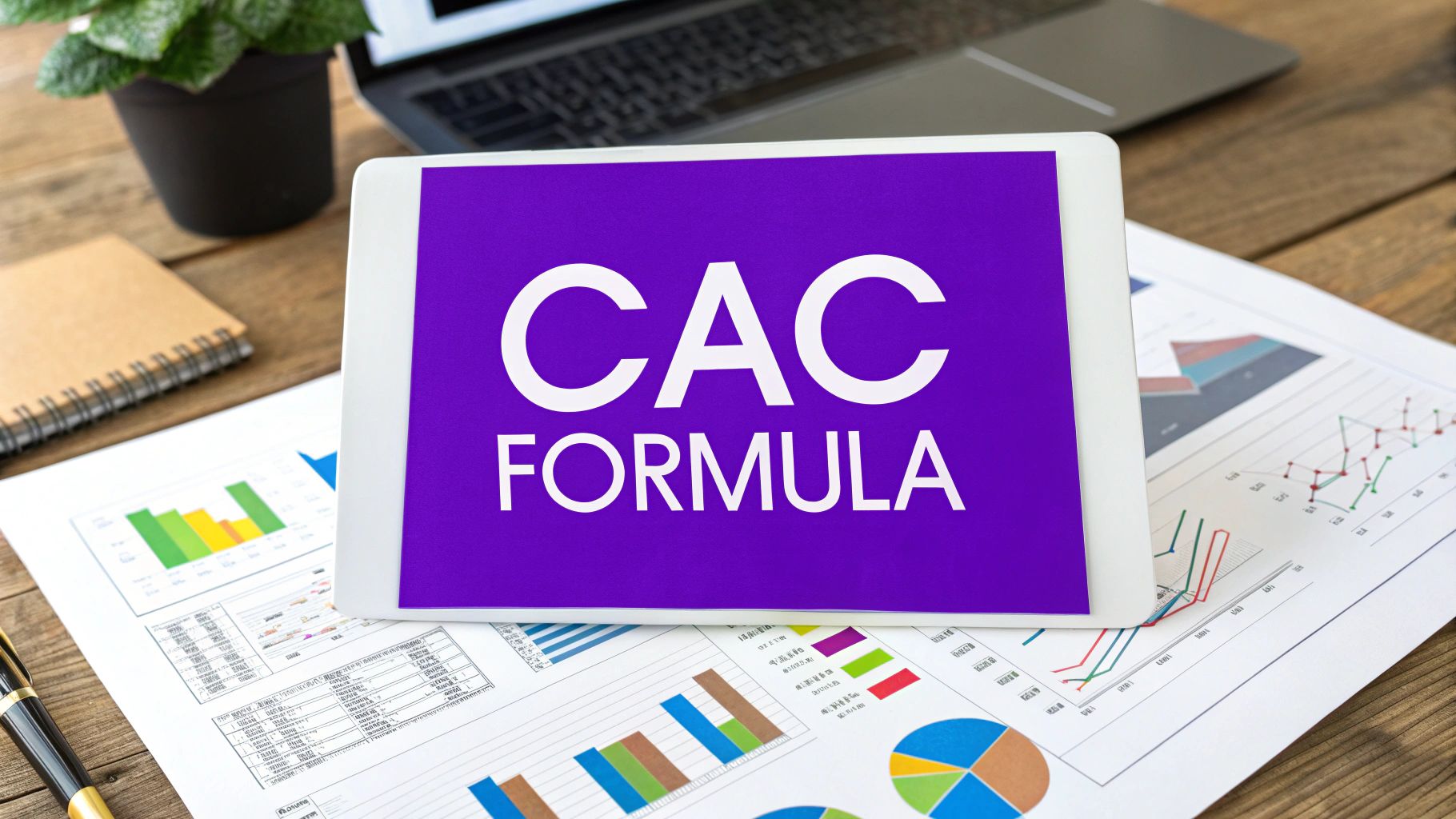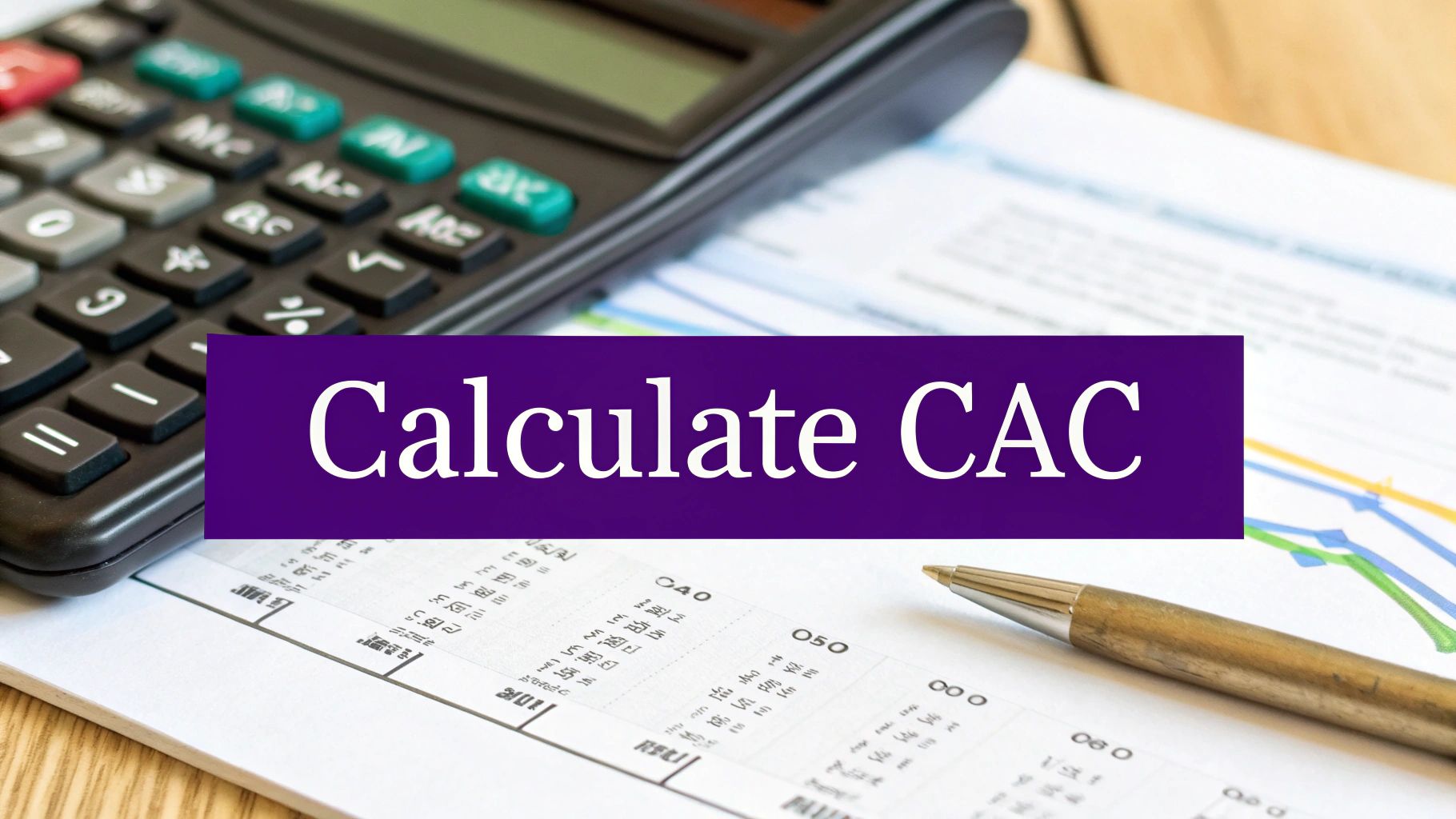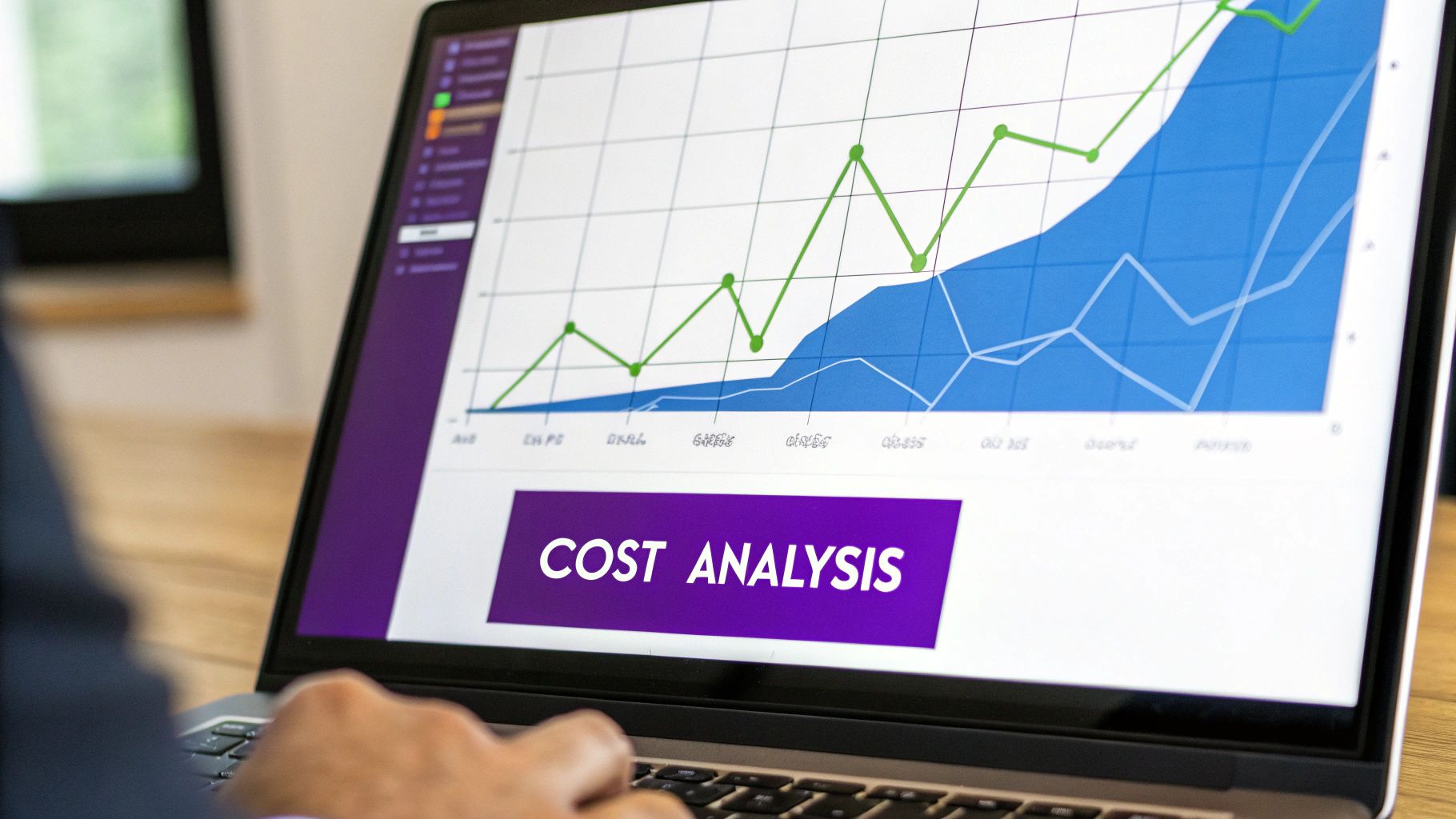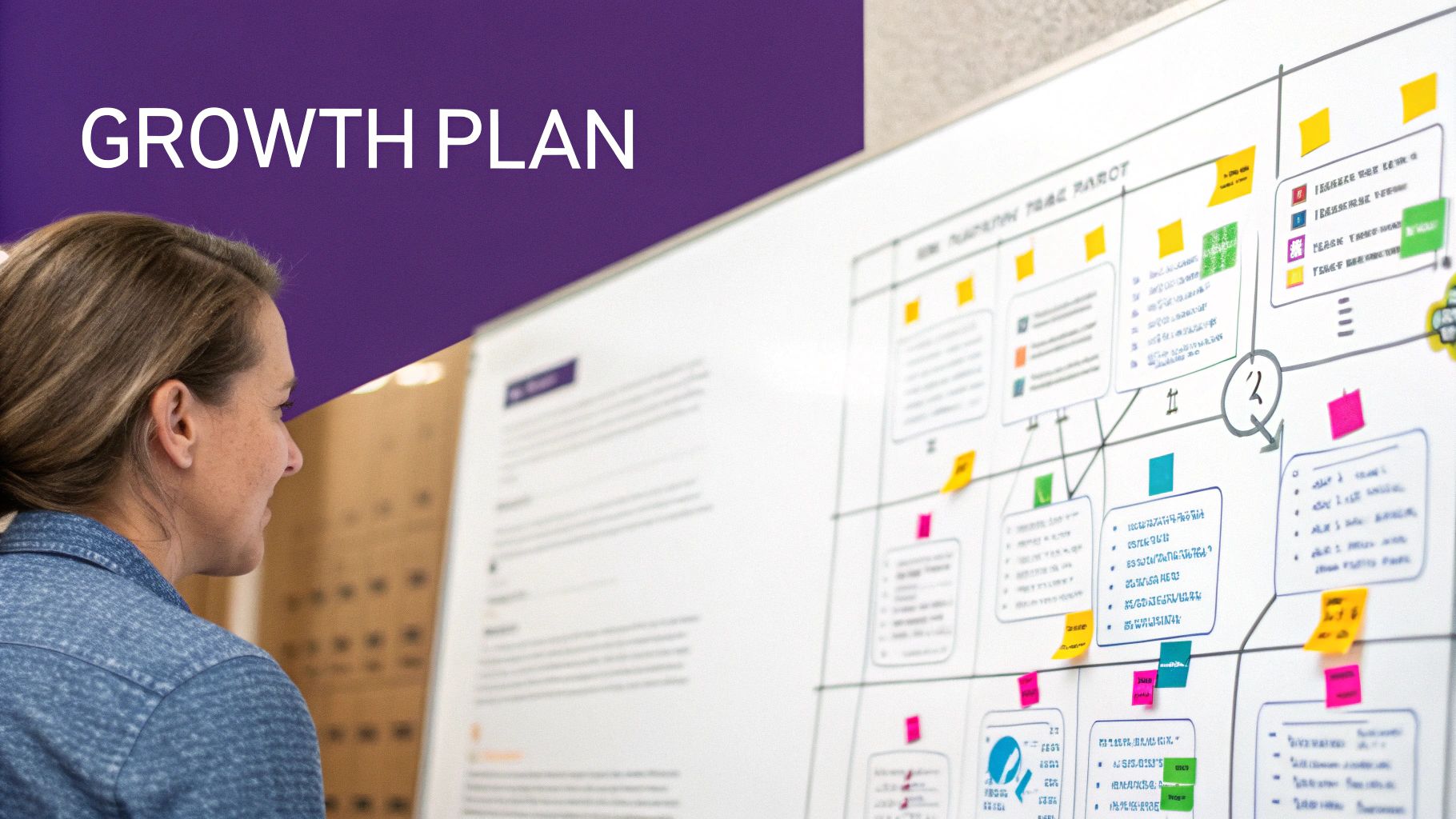Customer Acquisition Cost Formula: A Comprehensive Guide for Business Growth

Mastering the Customer Acquisition Cost Formula

Getting clear on your Customer Acquisition Cost (CAC) is key to understanding if your business is financially healthy. This number shows exactly how much you spend to bring in each new customer - giving you valuable insights into what's working (and what's not) in your marketing and sales.
Breaking Down the CAC Formula
The basic formula is refreshingly simple:
CAC = Total Marketing & Sales Costs / Number of New Customers Acquired
Let's look at a real example: If you spent $5,000 on marketing and sales last month and brought in 50 new customers, your CAC would be $100 per customer. This kind of clear data helps you see if you're getting good returns on your marketing spend.
Finding Hidden Costs
While the formula itself is straightforward, getting an accurate CAC means tracking all your real costs. Many businesses miss some key expenses, which leads to underestimating their true CAC.
- Direct Costs: These are the obvious ones - your ad spend, marketing tool subscriptions, and staff salaries. Most businesses track these well.
- Indirect Costs: These sneaky costs are easier to miss but just as important - think office space for your marketing team, utilities, and time other departments spend supporting sales.
- Blended CAC: If you sell different products or services, look at your overall CAC across everything. This gives you the full picture, especially if you have multiple product lines.
Getting these numbers right gives you an honest view of your costs. This helps you spot which marketing channels and campaigns actually make money. For more details on tracking acquisition costs, check out Amplitude's CAC guide.
Looking at CAC by Channel
Breaking down your CAC for each marketing channel gives you even more insights. For example, you might find that Instagram brings in customers for $50 each while Google Ads costs $200 per customer. This kind of specific data helps you put more money into what's working best and fix or drop what isn't.
Understanding Market Dynamics and Cost Evolution

Knowing your customer acquisition cost (CAC) is just the beginning. To succeed long-term, you need to understand how market forces and trends affect these costs over time. This means examining both your internal data and the bigger picture of what's happening in your industry.
The Evolving Landscape of Customer Acquisition
The way businesses connect with potential customers keeps changing. When more companies compete for the same customers, advertising costs often go up as everyone bids for popular keywords. Changes in how people shop, like the shift to mobile devices, mean businesses need to update their approach and tools. These changes have real impacts - customer acquisition costs went up 60% between 2019-2024. Key factors include Apple's privacy changes with iOS 14.5 and the move away from third-party cookies. Privacy laws like CCPA and GDPR add new requirements that often cost money to implement. Today, companies spend an average of $29 to acquire each new customer - that's over 200% more than in 2013. Learn more at Business of Apps.
Forecasting and Adapting to Change
Smart businesses develop flexible strategies to handle these shifting costs. They look at market data and what competitors are doing to predict future trends and plan their budgets. The most successful companies stay ready to try new approaches - testing different marketing channels and methods to keep costs in check as the market changes.
Building a Sustainable Approach
The best customer acquisition plans can change with the times. Simple steps like starting a loyalty program can help you keep existing customers, reducing the pressure to constantly find new ones. Building a strong reputation leads to more word-of-mouth referrals, which cost less than paid advertising. This balanced approach helps businesses grow steadily without overspending on marketing.
Smart Technology to Master Cost Optimization

Smart businesses today need to deeply understand their customer acquisition cost (CAC) to stay competitive. By using the right mix of online tools and data-driven methods, companies can bring in new customers more efficiently while keeping costs in check. The goal is simple - find ways to attract customers that make financial sense.
Smart Tools That Make a Difference
The right tech tools can help optimize your CAC in meaningful ways. For example, marketing automation helps personalize customer interactions at scale, which often leads to better conversion rates. Analytics platforms show you exactly which marketing channels perform best, so you can put more budget toward what works and less toward what doesn't. This data-focused approach helps make the most of your marketing spend.
Building a Smart Online Strategy
Success today requires rethinking how you connect with customers online. Focus on digital channels and use technology to create personalized experiences that work at scale. Consider running targeted ads on social media or search engines to reach specific customer groups. This precision targeting helps avoid wasted ad spend. You can also build engaged online communities and create helpful content to grow organically and rely less on expensive ads.
Real Results and Returns
The move to online sales has changed customer acquisition costs significantly. From 2014 to 2019, companies saw their CAC increase by 60%. However, online channels proved 30% more efficient at bringing in customers, helping offset rising costs. Many businesses found success by shifting focus to online sales to better manage their CAC. For more details, check out this analysis on CAC trends and online sales. The key is carefully tracking how each marketing channel performs and adjusting your strategy based on the data. This helps ensure you invest in what delivers the best results for your business.
Implementing Advanced Analytics for Strategic Insights
Want to truly understand your customer acquisition cost (CAC)? The key is in the analytics. By looking at your data strategically and examining customer behavior and campaign performance, you can find new ways to optimize spending and improve results.
Advanced Segmentation for Deeper Understanding
One of the most useful tools is customer segmentation. Rather than treating all customers the same, group them based on meaningful characteristics like demographics, purchase patterns, or website interactions. For instance, grouping customers by how they found your business (social media vs email marketing) helps identify your most cost-effective channels. This knowledge lets you craft targeted messages that resonate with each group.
Predictive Modeling for Future Success
Predictive modeling helps you stay ahead by using past data to spot future trends. You can anticipate changes in CAC and adjust your approach proactively. For example, you could identify customers likely to leave or determine which marketing campaigns will give the best returns. This foresight helps you make smarter decisions.
Integrating CAC with Other Key Metrics
Don't look at CAC alone. Connect it with other important numbers, especially Customer Lifetime Value (CLV) - the total revenue you expect from a customer over time. Understanding how CAC and CLV work together helps ensure you're spending the right amount to acquire customers who will bring long-term value.
Building Comprehensive Dashboards
Create a clear dashboard to track your progress in real-time. Include key metrics across all channels so you can spot areas needing improvement quickly. Track things like cost per conversion, conversion rates by channel, and CAC trends. This makes it easy to adjust campaigns and ensure your marketing budget works hard for you. By combining segmentation, prediction, and a complete view of your metrics, you'll build smarter acquisition strategies that drive growth.
Building a Cost-Efficient Acquisition Engine

Knowing your customer acquisition cost (CAC) is just the start. The real goal is creating a system that brings in customers without breaking the bank. Let's look at practical ways to make this happen.
Keep Your Best Customers Coming Back
Think of your customer base like a bucket - if it has holes (customers leaving), you'll always need to add more water (new customers). The smart move? Patch those holes by focusing on keeping your current customers happy. Here's how:
- Make Loyalty Worth It: Give your repeat customers special perks like early access to new products or exclusive discounts. When people feel valued, they stick around.
- Great Service Wins: Going the extra mile to help customers creates lasting relationships. Happy customers not only come back - they tell their friends about you.
Turn Happy Customers into Your Best Marketers
Nothing beats word-of-mouth marketing for bringing in new customers affordably. When your customers love what you do, make it easy for them to spread the word:
- Smart Rewards: Give both the referrer and new customer something valuable. It makes sharing feel good for everyone.
- Keep it Simple: Make sharing a breeze with easy-to-use referral links and social buttons.
Create Content That Attracts Customers
Good content brings people to you naturally, saving money on ads. Focus on making stuff your ideal customers actually want to read or watch:
- Get Found Online: Use the right keywords and best practices to help people find your content through search.
- Mix it Up: Try different types of content like blog posts, videos, and images to see what your audience likes best.
Fine-Tune Your Sales Process
Making your marketing funnel work better at every step means you get more value from every dollar spent:
- Smart Ad Targeting: Use your data to show ads to the people most likely to buy. Stop wasting money on audiences that don't convert.
- Easy Checkout: Remove any roadblocks that might stop someone from completing their purchase.
By getting these basics right - keeping customers happy, making referrals easy, creating helpful content, and smoothing out your sales process - you'll build a system that brings in customers reliably without excessive costs. It's about working smarter, not just spending more.
Preparing for Future Acquisition Challenges
Customer acquisition keeps changing as new tools, regulations, and consumer behaviors emerge. Let's look at key areas to focus on as we prepare for what's ahead.
The Rise of AI and Machine Learning in Acquisition
Artificial intelligence and machine learning are bringing new capabilities to customer acquisition. These tools help predict what customers want, create personalized messages, and handle routine tasks. For example, AI chatbots can qualify and nurture leads, helping reduce costs. Machine learning also analyzes customer data to find promising audience segments, making ad spending more effective. Smart automation is becoming essential for competitive acquisition.
Navigating Evolving Privacy Regulations
Privacy rules like GDPR and CCPA now shape how businesses collect and use customer data. While this adds new requirements around transparency and consent, it's also a chance to stand out. Companies that handle data responsibly build more trust with customers. Making privacy a priority pays off through stronger customer relationships over time.
Adapting to Changing Consumer Preferences
Today's customers expect a smooth experience across all the ways they interact with brands. This means businesses need an omnichannel approach - connecting social media, email, mobile apps, and other touchpoints. Understanding how people discover and choose brands helps create acquisition strategies that connect with target audiences.
Building a Resilient Acquisition Framework
To handle future changes, you need a flexible acquisition system. Key elements include:
- Regular tracking of market trends
- Testing new technologies
- Analyzing costs and results
- Using multiple acquisition channels
- Building strong customer relationships
This balanced approach helps manage risks while supporting steady growth. Staying adaptable lets your business thrive as acquisition continues evolving.
Ready to take your e-commerce business to the next level and optimize your customer acquisition process? Visit Wand Websites today to learn how we can help you build a high-performing online store and drive sustainable growth.


